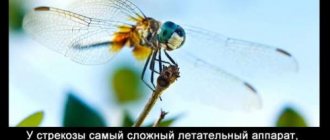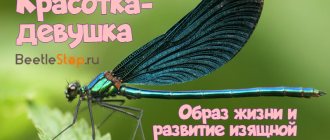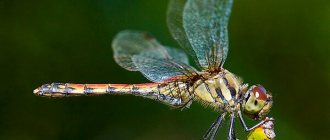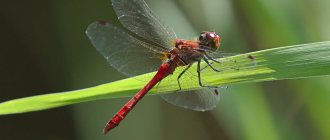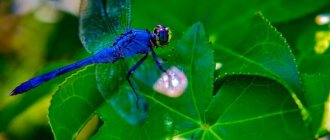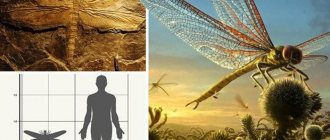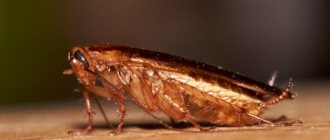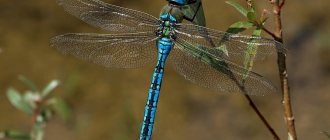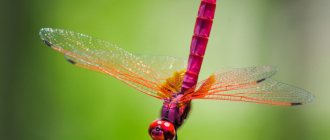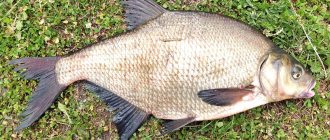You can always see a lot of brown dragonflies near ponds. This insect is distributed throughout the world. Currently, there are more than 6.5 thousand species of dragonflies. These insects have appeared since the time of dinosaurs.
Despite such a long history, at the moment the large rocker dragonfly, unfortunately, is under threat of species decline. The reason is the pollution of water bodies, which in turn leads to a decrease in the population of these beneficial predators.
Structure
The dragonfly, the structure of which we are considering in this material, has a long and very thin body.
It, in turn, is connected to the cephalothorax. On the dragonfly’s body we can see three pairs of legs and two pairs of wings. It is also important to note that the wings are transparent, they can have the same size and shape, or different. We will talk about this in more detail when we consider the types
The dragonfly, whose structure can vary by species, can belong to one of two main groups:
As you might guess, the first group includes individuals that have wings of equal length and shape, while others have the opposite (one pair can be very different from the other). On the dragonfly's head we can clearly distinguish large eyes and antennae. A little more about the senses. The eyes of these insects are complex. They can be divided into two sections:
- the top one, responsible for object recognition;
- the lower one, responsible for color recognition.
You've probably noticed that the transparent wings of dragonflies have veins along their entire length, and at their tips there are spots darker than the color of the wings themselves. This device helps avoid wing fractures by reducing vibration during flights.
Remember how flight occurs in other flying creatures. This is a beautiful and synchronized movement of the wings. Dragonflies have distinguished themselves here too; the movements of their wings can be asynchronous when they are balancing, but synchronous to increase speed
It is also important to know that these nimble creatures can reach flight speeds of up to 50 kilometers per hour.
An excerpt characterizing the Blue Rocker
Anna Pavlovna's living room began to gradually fill up. The highest nobility of St. Petersburg arrived, people of the most diverse ages and characters, but identical in the society in which they all lived; Prince Vasily's daughter, the beautiful Helen, arrived, picking up her father to go with him to the envoy's holiday. She was wearing a cipher and a ball gown. Also known as la femme la plus seduisante de Petersbourg [the most charming woman in St. Petersburg], the young, little princess Bolkonskaya, who got married last winter and now did not go out into the big world because of her pregnancy, but still went to small evenings, also arrived. Prince Hippolyte, the son of Prince Vasily, arrived with Mortemar, whom he introduced; Abbot Moriot and many others also arrived. -Have you seen it yet? or: – you don’t know ma tante [my aunt]? - Anna Pavlovna said to the arriving guests and very seriously led them to a little old lady in high bows, who floated out from another room, as soon as the guests began to arrive, called them by name, slowly moving her eyes from the guest to ma tante [auntie], and then walked away. All the guests performed the ritual of greeting an unknown, uninteresting and unnecessary aunt. Anna Pavlovna watched their greetings with sad, solemn sympathy, silently approving them. Ma tante spoke to everyone in the same terms about his health, about her health and about the health of Her Majesty, which was now, thank God, better. All those who approached, without showing haste out of decency, with a feeling of relief at the fulfillment of a difficult duty, walked away from the old woman, so as not to approach her once all evening. The young Princess Bolkonskaya arrived with her work in an embroidered gold velvet bag. Her pretty upper lip, with a slightly blackened mustache, was short in teeth, but it opened even more sweetly and sometimes stretched even more sweetly and fell onto the lower one. As is always the case with quite attractive women, her flaw—short lips and half-open mouth—seemed special to her, her actual beauty. Everyone had fun looking at this pretty expectant mother, full of health and vivacity, bearing her situation so easily. It seemed to the old people and bored, gloomy young people who looked at her that they themselves became like her, having been and talked with her for a while. Whoever spoke to her and saw her bright smile and shiny white teeth, which were constantly visible, with every word, thought that he was especially kind today. And that's what everyone thought.
The benefits and harms of dragonflies
It is difficult to overestimate the benefits of dragonflies. Both larvae and adults are highly voracious and destroy insects harmful to humans. Dragonflies eat mosquitoes, which is an invaluable benefit for people and animals. On the African continent, these long-winged insects eat Tsetse flies in large numbers. In addition, they themselves become part of the food chain of fish and birds. Also, according to research conducted by the Siberian Federal University, dragonflies help transfer up to 7 kilograms of fatty acids from water bodies to terrestrial ecosystems, which are necessary for the proper nutrition of organisms. However, the excessive appetite of the larvae causes quite a lot of damage to fish farms. They eat not only fry, but also the main food of fish (mosquito larvae, daphnia, etc.).
Threats to the species and conservation measures
Dragonfly larvae live in an aquatic environment and are sensitive to habitat pollution. As a result of human economic activity, various chemical compounds enter lakes and swamps that are harmful to nymphs and other fauna. The disappearance of coastal vegetation has a negative impact on the number of dragonflies. The large rocker is one of the insects that requires protection. It is listed in the Red Book of the Voronezh region. To stabilize the number of individuals, small ponds with a stable hydrological regime are required.
Features and habitat of the dragonfly
The description of the dragonfly should begin with the eyes of this insect, which at first glance seem disproportionate and too large relative to the overall size of the body.
However, dragonflies have so-called facet vision, which is due to the presence of several tens of thousands of small eyes, each of which works independently and is separated from the others by special pigment cells.
The structure of the dragonfly's eyes allows it to see even what is happening behind
Thanks to this strange eye structure, the dragonfly's vision is much better than many other insects and allows it to see everything that is happening behind, on the sides and in front and track prey at a distance of up to ten meters.
The dragonfly's body consists directly of the head, chest and long belly, which ends in a pair of special forceps.
The length of the insect ranges from 3 to 14 centimeters. Coloration is quite varied and can vary from white, yellow and orange to red, blue and green.
The wings have many transverse and longitudinal veins, which serve as reinforcements.
The insect dragonfly is an animal that is one of the record holders for the speed of movement: although the average speed of its flight is usually from 5 to 10 km/h, some species are capable of reaching speeds of up to one hundred km/h when flying over long distances.
So, despite the image of an idly staggering jumping dragonfly, created in one famous fable, this insect is very mobile and leads an active lifestyle.
Dragonflies have three pairs of legs, which are covered with a layer of protective bristles. During flight, the limbs of the insect fold into a “basket” in order to quickly grab prey if it is detected. The wings have dark spots that serve as vibration protection.
It is worth noting that the first jet aircraft took off due to the fact that entomologists shared with designers and engineers this structural feature of the wings of dragonflies, who used this element in the structure of aircraft, which would still crumble as soon as they left the surface of the earth, if would not be dragonflies.
The habitat of dragonflies is very extensive and extends from the territory of modern Europe and Asia to the African continent, Australia and America.
Dragonflies live mainly among meadows, fields and on the edges of forests. A prerequisite must be the presence of a body of water nearby.
Born predator
Without exception, all types of dragonflies (both nymphs and adults) feed on insects, often blood-sucking (horseflies, mosquitoes, midges). The dragonfly's body shape is ideal for hunting on the fly. These insects are “lean”, with a pronounced chest and elongated abdomen. The head of a dragonfly is very mobile. There are two complex compound eyes on it, allowing the insect to see everything that happens around and behind, and between these two there are ordinary ones, which serve for orientation in space. The organs of vision are designed in such a way that a dragonfly sees best against the sky. Therefore, she attacks the victim from below. The insect has a powerful mouth (“gnawing,” as scientists say), short antennae and stiff legs covered with hairs that help capture prey. Each representative of the order has two pairs of wings, which are equally well developed. This means that it is a bimotor insect. Dragonflies can fly at speeds of over 55 km/h.
Behavior
The dragonfly is a solitary hunter by nature. She can fly for many hours in a row at a speed of 9 m/sec and with a frequency of wing flapping up to 20 times per second. This insect is capable of flying long distances, but is a poor pedestrian. It may occasionally sit down to rest.
The large compound eyes consist of 28,000 simple ocelli.
A movable head and compound eyes make it much easier for this voracious creature to find food. The oral apparatus is armed with a pair of powerful jaws. The basis of its diet are mosquitoes, butterflies and mayflies.
The blue yoke eats small insects on the fly, and having caught a larger one, sits on the nearest plant and calmly eats it. After eating, it carefully cleans its paws and takes flight again.
With the onset of dusk, numerous flocks of dragonflies hunt for midges. In the heat of the hunt, they fly away to long distances from the reservoir, and sometimes they can fly into human habitation.
Lifestyle
Insects are excellent flyers; they can reach speeds of up to 55-60 km/h. Their flight is characterized by planning. While looking for prey, dragonflies are able to hover in the air for a while. They fly several kilometers in search of comfortable habitats. Dragonflies are active during the daytime. They love warm sunny days. On a cool morning, adults can be seen basking in the rays of the rising sun. The great rocker is one of the species that are active not only during the day, but also after sunset. They spend the night on the treetops. The adult summer period is from July to September.
Dragonflies are reliable human assistants in the fight against blood-sucking insects. Adults destroy mosquitoes and gadflies on land, and nymphs destroy mosquitoes in bodies of water where pests lay eggs. In a swift flight, dragonflies in flight grab flies and mosquitoes with their paws, and can catch a butterfly or even a small dragonfly.
The larvae thrive in stagnant or low-flowing water with a large number of plants. Weak limbs prevent nymphs from traveling and pursuing prey. They hunt from ambush. During the throw, the larva releases a stream of water, which sharply throws it forward towards the prey. Its breathing mechanism is designed so that the tracheal gills are located in the rectum. The nymph swallows a large amount of water and receives oxygen, the liquid is excreted through the anus. To capture prey, the larvae have a special organ called a mask. This is a modified lower lip, equipped with a movable joint and grasping teeth.
After 2 years of development, the larva moves to land, where it settles on a vertical surface for its final transformation. Her skin dries out and cracks on her back. A dragonfly emerges from the old, tight skin. Her wings are soft and unformed. They wait for several hours for their wings to spread and harden. The final coloring takes several days to complete.
Beauties
In general, the order of dragonflies stands out among other orders of insects for its aesthetic merits. And it’s basically impossible not to admire the representatives of the family of beauties. For example, beautiful girls are small (up to 5 cm long), thin even-winged dragonflies with a wingspan of no more than 7 cm. The body and wings of males are colored in blue, green, purple shades and have a metallic sheen.
In females, the body is colored, but the wings are not. Beauties prefer the overgrown banks of quiet rivers and small streams. They lay eggs in the leaves of coastal plants; The larvae also try to stay close to the stems and roots. The flight of a beautiful girl resembles the flight of a butterfly.
Habitats and biology
It is confined mainly to mixed, partly to deciduous forests with natural reservoirs of boreal origin. Habitats: peat bogs with areas of open water, small standing reservoirs and river backwaters with coastal tall grassy vegetation. Eggs are laid primarily on coastal mosses, areas of loose damp soil, and dead plants. Egg development with wintering; The larvae hatch at the end of summer and develop for 3 years. Larvae and adults are predators, hunting smaller invertebrates; Older larvae can attack fish fry and tadpoles. To transform into an adult, the larva crawls onto coastal plants at least 0.5 m high. Adults were recorded from late June to September. Active during the day, they usually fly and hunt near breeding sites, but some individuals can fly many kilometers away. They sit down relatively rarely and are very shy.
Reproduction
The breeding season lasts from June to October. During this period, cavaliers actively patrol areas with ponds and lakes in search of females
Flying over the surface of the water, the male performs intricate acrobatic acts in the air, trying to attract the attention of his partner. Females are limited to rapid flights in a straight line
After mating, the male flies off to patrol the surrounding area again. Females and males mate with different partners. After mating flights, the fertilized female looks for a place to lay eggs. Wet moss or dead parts of the plant are suitable for this.
The female pierces the plant with her ovipositor and lays eggs in several rows. Only in the spring of next year will larvae 3 mm in size emerge from the eggs. Very soon they will begin their first molt. The blue rocker larva undergoes the molting process 10 times.
Living in a reservoir, it actively eats fly larvae, caddis flies and a variety of small invertebrate animals. She hunts with the help of a “mask”, which has 2 claws. During rest, this device is neatly folded under the chest. At the right moment, the larva opens it and sharply throws it forward, as a result the victim falls into a trap.
The way of breathing changes completely, the eyes become larger. The wings, located in small pouches, increase in size.
At dusk, the larva leaves the pond and, coming ashore, climbs onto a blade of grass. After some time, a small crack forms on her back and head, and the final molt occurs. A completely adult insect is born. Its soft wings spread out and after a while harden.
The blue yoke goes on its first flight. The larvae that appeared at the beginning of the season stop growing with the onset of cold weather and only leave the reservoir the following spring to complete metamorphosis. Larvae that were laid at the end of the mating season develop very slowly. They complete the transformation within 2 years.
The life of the imago undergoes 3 periods of development. In the first period of maturation (up to 16 days for females, and up to 12 for males), males show off in dazzling decoration.
The second stage lasts about 60 days and is entirely devoted to the continuation of the family line. During this period, many individuals die. With the advent of the third period, the dragonfly's dazzling outfit fades, its worn-out wings refuse to serve, and the insect dies.
Distribution area
Both species are characterized by a brown chest and abdomen, but the green-eyed dragonfly has transparent and uncolored wings and green eyes; there is also a characteristic yellow triangular spot on the second abdominal segment. The brown dragonfly has yellowish wings and bluish eyes. The green eyes of the first type of dragonfly are noticeable even in flight, so it is not difficult to distinguish these two types of dragonflies. In addition, the green-eyed dragonfly emerges from hibernation much earlier than the brown one.
Range and habitat The rufous rocker lives in Central Europe and in countries around the Mediterranean Sea, including the lowland regions of North Africa.
It is more common in Eastern Europe than in the southwest of the continent. In Spain and Portugal it lives only in certain areas. Inhabits damp, densely vegetated areas: Conservation status in the UK The tawny rocker has always been a rare species in the UK.
Found only in certain areas of the country. It was found in the lowland marshes of Cambridgeshire, but by the beginning of the 1990s this population had seriously declined. Behavior Dragonflies emerge from hibernation earlier than many other dragonflies.
Flies from May to August. Adults usually fly less than other dragonflies of the genus Aeshna. Males defend their territory by circling over a selected area of the reservoir.
If the body of water is small, the male hovers over its center. Unlike other dragonflies of the genus, whose males constantly circle from end to end of their hunting grounds, the male green-eyed dragonfly rests from time to time, landing on some plant. The female lays eggs on plants growing above the water.
The larvae hatch after 2 weeks and become adult dragonflies after 2 years. Part 2. Red Book Laboratory of the All-Russian Research Institute for Nature Conservation, Five-language dictionary of animal names: RUSSO, Dragonflies of Eastern Europe and the Caucasus: Partnership of Scientific Publications KMK, IUCN Version
Appearance of insects
Great Rocker Dragonfly: An insect easily identified by its brown wings. Distribution area of the dragonfly, features. noun, number of synonyms: 2 • rocker (11) • dragonfly (43) ASIS Dictionary of Synonyms. V.N. Trishin. Rocker flies (Aeshnidae) are a family of dragonflies from the suborder Anisoptera. There are about species in the family Aeshnidae around the world. a) Larvae of the rocker-fly type (Aeschna) with an elongated body and a flat mask. This includes the largest species that are similar to each other.
Instructions: Rocker arms - Wikipedia
A large rocker hung over the lake Published: Once, near a shallow lake overgrown with sedge, I observed a whole flock of these amazing insects, either circling over the water surface, or rapidly soaring upward. The golden dragonflies with blue spots on the abdomen and long transparent wings were very large. Here one of them boldly sat on an outstretched finger, I saw huge bulging eyes on the sides of her head. I tried to pet the dragonfly, and she, ungrateful, unexpectedly grabbed my finger.
Arrows
Arrows are not as spectacular as beauties, but just as graceful dragonflies. The photo of the graceful arrow, posted below, confirms this fact.
Shooters lead the same lifestyle as beauties, except that they choose more modest prey. And it is not surprising, because the body length of the graceful arrow is only 3.5 cm, while the wingspan is 4.5 cm. The male has an elongated blue chest with a longitudinal black stripe and a black abdomen, as if intercepted by thin blue rings. The wings are narrow and transparent. Some females have a similar coloration, others are rather inexpressively colored and have neither stripes nor rings. Arrows fly slowly and rarely leave their homes. Their larvae live and hunt in the stems and roots of aquatic plants. Distinguishing one species from another within this family is not an easy task. But it is impossible to confuse them with another family of arrows.
Notes
Wikimedia Foundation. 2010.
Blue rocker
, or
reed yoke
(Aeshna juncea) is a species of dragonfly in the yoke family (
Aeshnidae
).
The reed yoke is one of the largest species of dragonflies in the genus. It is common in Eurasia and North America. Flight lasts from June to early October.
The reed rocker reaches 74 mm in length. The male's body is brown above, black on the abdomen with paired blue and yellow spots on each abdominal segment and a narrow stripe along the dorsal surface of the thorax. Females have a brownish-yellow belly, sometimes with green or blue spots.
Grandfathers
Among the features of these dragonflies are the variegated coloration, widely spaced eyes and the presence of a notch at the base of the hind wings in males. Grandfathers are capable of long flights and prefer flowing reservoirs with clean water, where females lay eggs directly in flight.
Common dedka, tailed dedka and horned dedka are the most common species of dragonflies in Central Russia. These names sound funny (as well as “metal grandmother” or “bronze grandmother”), but you need to keep in mind that grandfathers are also called rivermen, and grandmothers – patrolmen. The Common Dedka is a black and yellow dragonfly with transparent wings. The coloring is vaguely reminiscent of wasp.
Dedok larvae are voracious, strong and can burrow into soft mud. And adult grandfathers, oddly enough, are short-lived. They live no longer than a month.
Blue rocker (Aeshna cyanea Mull.)
The length of the abdomen is 51-60 mm, the length of the wing is 44-49 mm. These dragonflies are distinguished by their extremely variegated coloring, which alternates between spots and stripes of blue, black, yellow and light blue. Males of this species can be reliably distinguished in the field by the downward curved tips of the upper anal appendages, which end the abdomen. The species is distributed throughout the European part of Russia with the exception of the Kola Peninsula and the North. Ural. It lives in very different landscapes, both in forests and in large open spaces. They fly from July to October. Larvae often live in very small stagnant bodies of water, even artificial pits with a diameter of no more than 3 m. Running water is avoided.
Dragonfly insect. Dragonfly lifestyle and habitat
The dragonfly is one of the most ancient insects inhabiting our planet. Their distant relatives, who lived more than three hundred million years ago (long before the appearance of the first dinosaurs), had very impressive dimensions, exceeding the size of many modern birds.
The wingspan of these prehistoric giant insects reached one meter, it is not for nothing that the name “Dragonfly” is still preserved in English, which literally means “flying dragon”.
In Latin, the dragonfly insect is called “Libella” - small scales. This name is due to the fact that the insect's wings resemble scales during flight.
This insect is very popular among the people, as evidenced by its repeated mention in literature (the famous fable “Dragonfly and the Ant”) and in the modern music industry (the song “White Dragonfly of Love,” which has long been at the top of various charts).
The golden dragonfly, in turn, is considered a powerful amulet that brings good luck.
Reproduction and lifespan
When instinct begins to encourage male dragonflies to reproduce their own kind, they unite with each other and form large flocks, rushing in search of partners. But first, they secrete a capsule with seed and carry it with them until they find a suitable female.
Driven by this goal, they explore territories located in close proximity to bodies of water, since the reproduction of these insects is directly related to such an element as water. But the process of copulation itself in these living organisms occurs in the air.
At the same time, males hold females with their claws, capturing their head. During intercourse, the couple is able to move through the air in a coupled state.
After fertilization, the female partner goes to water (rivers, streams, swamps, ditches, ponds), where she lays eggs, the number of which can reach up to six hundred. They are usually deposited on plants growing above and below water. After a few weeks, naiads (dragonfly larvae, also called nymphs) emerge from such clutches.
The naiad develops and grows in the water element, where it also finds food by hunting. The peculiar vision of the larvae allows them to see their victims only during moments of movement. When hunting, they shoot water at their prey. And in case of danger, the naiad is able to escape from the threat by developing a fairly high speed, which it achieves by pushing air out of the anus.
At the same time, the naiad constantly molts and grows, shedding its tight old skin. And the number of lines can reach up to one and a half dozen. In the final stage, the dragonfly turns into an adult insect. Her wings spread, and she continues her life in the air element.
The duration of feeding of the larvae depends on the amount of food in the immediate vicinity of it. He believes that in this state a dragonfly can live up to five years. True, this is only in exceptional cases, because for the most part the lifespan of such insects, even in all three stages of their existence, is very short.
However, it is directly dependent on the habitat and size of these creatures. On average it is no more than ten months. But the largest individuals, under favorable circumstances in the wild, are quite capable of successfully carrying out their life activities for seven or more years.
These creatures are very useful for humans. After all, they destroy blood-sucking insects in large numbers, pests of forests and agricultural land. In addition, the dragonfly is a pollinating insect, and works to help plants reproduce, along with bees and butterflies.
True, the larvae can cause significant harm. They compete with fry in food, which contributes to a reduction in their numbers.
source
Classification of modern dragonflies
The unique features of morphology and behavior did not allow dragonflies to be combined with other insects and they were separated into a separate order Odonata.
It is worth noting that dragonflies also belong to the infraclass of ancient winged insects, that is, insects that are not able to fold their wings behind their abdomen. It is interesting that in the entomofauna of the planet, in addition to dragonflies, only mayflies have this feature.
The order Odonata includes 3 suborders:
- Anisoptera or heteroptera dragonflies, in which the rear pair of wings is wider than the front at the base;
- Zygoptera or homoptera dragonflies have wings of exactly the same shape and size;
- Anisozygoptera is an extremely small suborder of dragonflies preserved from the Mesozoic era (251 - 68 million years ago), including only 4 species. Their representatives have characteristics of two main suborders.
Suborders of dragonflies form dozens of superfamilies and families. The most famous families of Homoptera are the lutes, beauties, pseudocrests, flatfoots and arrows. Among the representatives of heteroptera, the most studied are club-bellies, true dragonflies, grandmas, grandfathers and rockers.
Dragonfly families include genera and many species with similar morphology and some individual characteristics.
Dragonfly in flight.
Dragonfly.
Dragonfly.
Dragonfly in flight.
Dragonfly.Dragonfly.
general description
All dragonflies belong to the subclass of flying insects belonging to the order of six-legged arthropod insects. And this species has more than 6.5 thousand varieties, which are classified into three suborders:
- Homoptera (Zygoptera);
- heteroptera (Anisoptera);
- mixed species (Anisozygoptera).
Dragonflies are quite large in size, have a large movable head, and large eyes. Their body is elongated and slender, has two pairs of transparent wings with veins. Insect habitats cover almost all countries and continents, excluding permafrost areas.
Representatives of this order are classified as amphibiotes, since eggs and larvae go through their developmental stages while in water, while adults live on land and fly well. Most often, stagnant ponds, small lakes, streams, and even artificially created ditches and ditches filled with water become home for larvae.
Real dragonflies
This family of the heteroptera suborder includes numerous species of dragonflies. Their names speak for themselves: swamp, flat, blood. These insects are distinguished by a massive, wide and relatively short body, wings slightly shifted towards the head and the presence of dark spots at their base. The female true dragonfly lays eggs directly into the water of a pond or quiet river, and sometimes into coastal sand. Large nymphs of true dragonflies live in the mud. The flat dragonfly is a medium-sized insect. The wingspan is 8 cm, the body length is 4.5 cm. Both females and males have a brownish-yellowish chest, but the male's abdomen is covered with bright blue pollen, while the female's abdomen is brown, with dark stripes on the sides. At the base of both pairs of wings there are dark triangles. The eyes are greenish.
Other representatives of the family are very noteworthy - blood dragonflies (photo below). They are easily recognized by their bright body color - reddish-yellow, orange or brown-red.
These dragonflies are one of the latest. They are active from mid-summer until November. The transformation of blood dragonfly larvae into adults occurs in just a couple of months.
Appearance of insects
The large rocker is a dragonfly that belongs to the family and genus of the rocker. The large insect reaches 60-75 mm in length, the hind wing is 45-49 mm. The female has a brown abdomen with small yellow spots. The chest is also brown, with oblique yellow stripes on the sides, and covered with hairs. Males have a brown or brown body, with blue spots on the side of the abdomen.
Information. The Russian name of the genus “yoke” is associated with the special posture of females who are not ready for mating. Insects bend their abdomen in the form of a rocker, refusing fertilization.
A characteristic feature of Aeshna grandis is that the compound eyes touch over a short distance. The complex structure of the organ, consisting of many small eyes, allows the insect to look simultaneously in several directions and quickly navigate in flight. The jaws are strong, the mouthparts are of the gnawing type. A dragonfly is not able to bite through human skin, but it easily tears flies and mosquitoes into pieces. The antennae or antennae are short and consist of 4-7 segments.
Features of the structure of the wings
The wing plates are transparent and smoky. The veins are brownish-golden. At the apex of the fore wing there is a noticeable dark brown thickening. This is a pterostigma, a dense area that allows you to increase the amplitude of the wing span and dampen dangerous vibrations. Each wing consists of two chitinous layers with their own system of veins.
The species large rocker belongs to heteroptera dragonflies. In representatives of this large group, in a calm state, the wings are located perpendicular to the axis of the body. When flying, they can use each pair of wings separately, which gives them wide maneuverability. Long limbs brown. They consist of 5 main parts, the thighs and lower legs are covered with two rows of spines. Each paw ends with a sharp claw. The forelimbs are necessary for dragonflies to hold prey, the rest for landing and take-off. Long flexible legs with spikes serve as a strong basket for catching insects.
Reproduction and development of dragonflies. How is a dragonfly born?
During the mating season, male dragonflies gather in huge flocks and patrol areas located near water bodies.
After fertilization, the female dragonfly flies to a pond and leaves eggs directly in the water, placing them inside underwater or above-water parts of plants.
The number of dragonfly eggs can reach 600 pieces.
How dragonflies lay eggs
Dragonfly eggs
The development cycle of dragonflies is incomplete. The transformation into a mature individual occurs without the pupation stage.
The egg stage lasts from 14 to 35 days. After which a naiad larva emerges from the egg and continues to develop under water. The naiad breathes using peculiar gills located in the hindgut. To supply the body with oxygen, the larvae constantly suck water into it through the anus. They push the “waste” liquid out with force and thus move using the principle of a jet engine.
During the larval stage, the dragonfly molts up to 15 times. During growth, wings begin to appear, although at the moment the insect comes out into the air, they are still fragile.
The last change of “skin” occurs on land, and an hour later the dragonfly is ready for its first flight. The larval stage can last up to 3 years, and its duration depends on the type of dragonfly.
Like a torpedo
While naiads live underwater, they hunt other larvae (not disdaining their fellows), tadpoles and even fry - in a word, anything that fits into their mouths. And their mouth is unusual: when the victim approaches, the naiad sharply throws its mask forward - something like a lower lip with teeth - catching and pulling it up. In addition, their unique vision allows them to distinguish what moves in the water.
And at this time, their parents are upstairs hunting for mosquitoes, midges, flies and other disruptors of human sleep. Because all dragonflies are predators. They are gluttonous, picky and can eat many times their weight in a day. Their jaws extend almost the entire head, so they deal with food right in the air, without even landing. The dragonfly begins hunting at dawn, and at dusk it hides in the vegetation and sleeps.
Another difference between an adult is the way it breathes. In winged animals it is tracheal (as in many insects), and the larvae breathe through the intestine with oxygen dissolved in water. Naiads are able to release a stream of water from this very intestine in order to gain acceleration, like a torpedo.
While living underwater, a naiad can change its chitinous skin more than ten times. During the last molt, she climbs out of the water and finally gains wings.
The Internet describes cases where a large dragonfly bit a person.
Dragonfly: structure, description and photo
In this article we invite you to talk about what kind of creature this dragonfly is. Structure, nutrition, reproduction, benefits and harm - all these are our main questions, to which you will find the answer by reading this short article.
First, let's make a reservation: the dragonfly has six jointed limbs. This is an insect belonging to the subclass of winged insects. These numerous creatures even have their own squad - dragonflies.
Have you ever wondered how dragonflies got their name? In Russian it is a combination of two obsolete words: fidget and strekat. The first word is translated as fidget, and the second - jump. This name fully characterizes the flight style of these fast creatures called dragonflies. Structure is the first issue we will look at right now.
Lifestyle and habitat
Dragonflies spread successfully only to those areas of the planet where stable negative temperatures are not observed for more than three months a year. Their widespread distribution and species diversity is largely explained by the ancient origin of these insects, their ability to move quickly and actively in space, as well as a variety of food sources and taste preferences.
The lifestyle of such insects is inherently amphibiotic. This means that the eggs and larvae of such living organisms go through the stages of their development in water, while adult individuals (imago) carry out their life activities in the air and on land.
These are excellent flyers, as can be easily seen by observing dragonflies in the summer. They are agile and fast and are kind of champions among insects, developing significant speeds through the air, which in some cases can reach up to 57 km/h.
It should be noted not only the speed, but also the art of flight, as well as the maneuverability of these creatures, in which their streamlined bodily forms greatly help them.
The air element can truly be considered a home for the dragonfly. On the fly, she is able not only to dine, but even to mate. Moreover, these are very aggressive, cruel predators, and therefore many living organisms from the insect world have cause for concern if they see the shadow of a dragonfly.
These creatures, having occupied a certain territory, jealously guard it from competitors and fiercely fight for it with their own relatives.
Pilot from God
Like the cheetah among animals, the dragonfly leads among insects in speed of movement. Its largest types can compete with cars: they can accelerate to 100 km/h. But most bench press half as much - and this is still faster than the speed of an Olympic runner (about 40 km/h).
Lightning speed plus maneuverability make her an ideal hunter - she attacks so quickly and suddenly that in 95% of cases the victim simply does not have time to fight off the attack. For comparison: even sharks and lions misfire more often. A dragonfly is capable of calculating with mathematical accuracy the trajectory of a gaping booger and abruptly starting from a place to the desired point. Accelerating, she crashes into a bug, stunning it. But it does not harm itself, thanks to its dense chitinous armor.
It's all about the amazing structure of her wings - they create such a manner of flight that they seem to ignore any laws of physics. She can make each wing move separately, "switch gears" in a split second, changing speed and direction in full flight, and even fly backwards.
Reproduction and lifespan of dragonflies
Mating of dragonfly insects occurs on the fly. It is certainly preceded by a mating dance, performed by the male to attract the female to himself.
After mating has occurred, the female lays up to two hundred eggs in one clutch. Subsequently, a dragonfly larva emerges from the egg, the development of which takes a very long time, up to five years.
The photo shows a dragonfly larva
The larvae are already predators and even prey on tadpoles, although they themselves often become prey for some species of fish, so that out of hundreds of larvae, only a few individuals survive.
The lifespan of a dragonfly reaches seven years, taking into account all stages from the larva to the adult, which can live about one month in the wild.
Homes do not actually breed such insects, so you can limit yourself to observing them in their natural habitat and viewing photos of dragonflies on the Internet.
source
